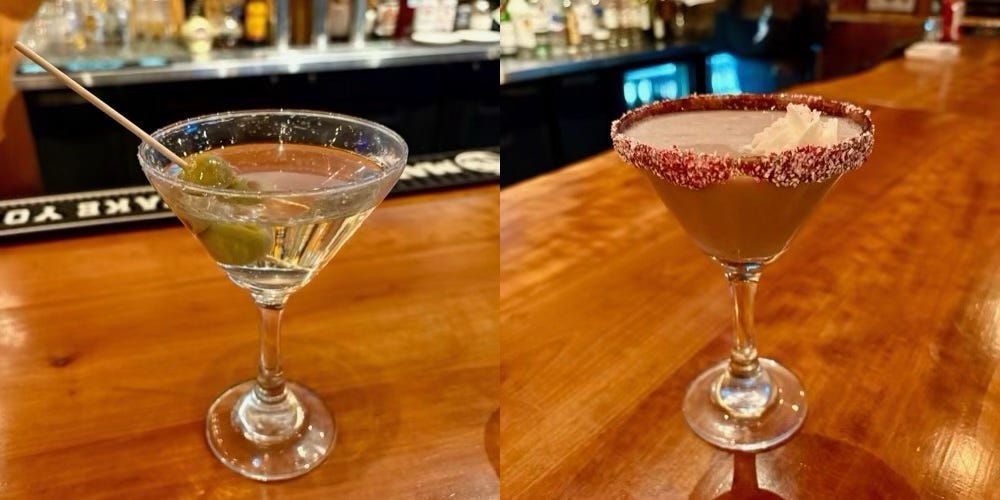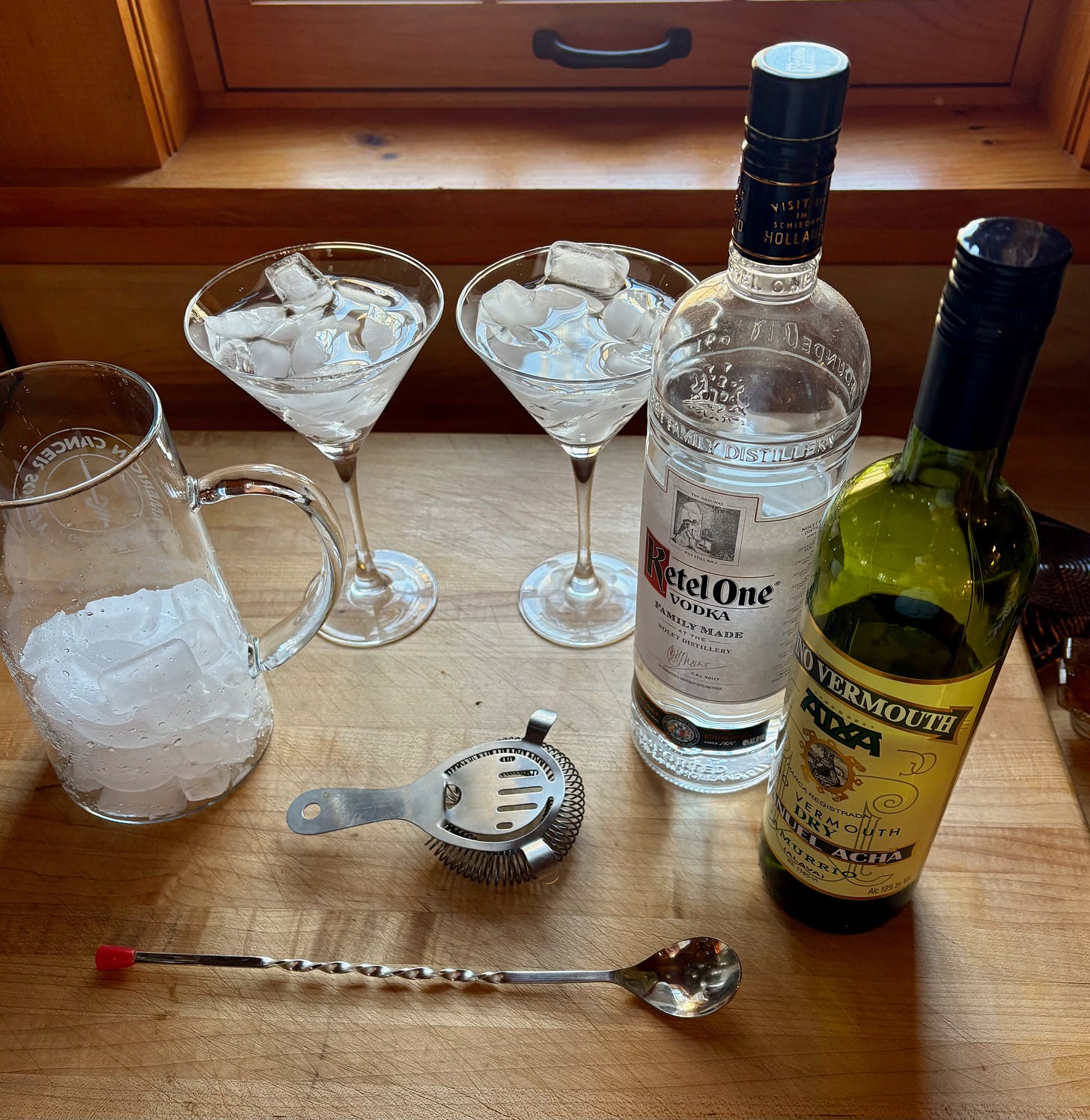How to make a proper martini
Gin or vodka, vermouth, ice. Full stop. Please(!)
My Adirondack Diary. December 28, 2024
I wrote this week’s diary entry with no small amount of trepidation. The topic is a contentious one, and will, no doubt, find some readers who will take issue with my position. I am referring to the making of a classic and proper martini. Specifically, we first need to address what a martini is, and more importantly, what it is not, and lastly, the proper way to construct one. My position is not an opinion. It is, in my view, a statement of fact, and not open to negotiation, or even discussion. I can document this with written historical evidence which you can easily find yourself on the internet—so it must, therefore, be true.
I first tackled this issue decades ago, when I was writing about food and wine for the Poughkeepsie Journal, and years later in a column on my old website, North Country Rambler. Alas, in the ensuing years, the bastardization of this cocktail has only gotten worse, with impostors now crowding the field to the extent that many bartenders no longer remember how an actual martini is made. Restaurant cocktail lists will offer chocolate-tinis and apple-tinis and espresso martinis and cherry martinis. Last week I observed a green foamy thing being served in a crushed cookie rimmed martini glass, which bore absolutely no resemblance to an actual martini. Serving these concoctions in a martini glass does not make the drink a martini any more than serving tomato juice in a pint makes it a beer.
On Saturday we stopped at one of our usual haunts for dinner, which we usually take at the bar. One of the owners, seeking to curry favor with my wife or to aggravate me—and accomplishing both—sent over one of the evening’s specials, a “martini” cocktail called a “Not-So-Hot-Chocolate-tini”. Described as a blend of chilled hot chocolate, vanilla vodka, crème de cacao chocolate liqueur, and Bailey’s Irish Crème, our server slid the peppermint sprinkle rimmed glass across the bar with a look that can only be described as the look of a third grader presenting a C-minus report card. “This is on Gary”, she apologized, I assume in an attempt to deflect blame to the ownership. How did we get here? These cocktails may very well be delicious, but they are not martinis. Let’s show some respect.
A Proper Martini *********** Not a Martini
I have also watched over my lifetime as the preparation of a proper “dry” martini has gone from using a 3/1 ratio of gin or vodka to vermouth, to a thimble full of vermouth, to a few drops of vermouth, to an atomizer spray of vermouth, to using the vermouth bottle to “bless” the martini with a sign of the cross or to current day where a “dry martini” is a glass of chilled gin or vodka with no vermouth at all. I have had bartenders look me in the eye and—usually around the time that I am politely observing that they have forgotten to use vermouth—tell me that “nobody wants vermouth in their martinis, so we don’t use it anymore.” I am sorry, but a chilled glass of gin with no vermouth is not a martini, it is a chilled glass of gin, and if I wanted a chilled glass of gin, I would order one. Importantly, I am using the phrase “proper martini” deliberately, as opposed to “perfect martini”. A perfect martini is actually a specific drink, similar to a perfect Manhattan in construction, using both dry and sweet vermouth.
The recipe for making a martini is, or should be, blessedly simple: gin or vodka if you prefer, dry vermouth, ice, and an olive or twist of lemon for garnish. Period, hard stop. No chocolate, no apples, no cherry liquor, no green foamy stuff. You do not tamper with perfection.
The origins of the martini cocktail are as cloudy as an afternoon after a three-martini lunch. Most agree that Martini & Rossi vermouth has something to do with the name, but others attribute an early 1900’s San Francisco drink – the Martinez cocktail – as the genesis of the drink that we now know. A Martinez had similar components, but with added sweeteners. I prefer to think that Nick Charles’s character in “The Thin Man”, circa 1934, thought it up to impress Nora. Lord knows Nick perfected the art of making them. Younger readers may want to consult You Tube about Nick & Nora or ask your grandparents. There actually is a style of martini glass—a Nick & Nora — so named in their honor. In any event it is an elegant drink, certainly one of the most popular cocktails of all time. It is also one of my favorite cocktails. Actually, not one of – it is my favorite, period.
A long-ago NPR commentary referred to the martini as an “urban drink”, which I suppose has some validity. I suspect that one of the reasons is that most city dwellers don’t have to drive home after a few martinis at cocktail hour. They walk or grab an Uber. They often have to. Martinis have a habit of doing that. A friend of mine would often state (while raising his first martini to his lips) that every really stupid thing he had ever done could be traced directly to a martini. Fair warning.
The ingredients in a martini are easy enough to come by. Having made a few thousand in my lifetime, I will offer this “Idiot’s Guide to Making a Proper Martini” and I apologize if there is actually a book out with the same title.
First, you must have all of the components in place, ready to go, before you start.
You will need:
A bottle of gin or vodka of your choosing. It should be room temperature, not frozen! More on this later. You will need a reasonably fresh bottle of dry vermouth (the green one). Vermouth has a short shelf life. Just because you store it next to the gin bottle in the closet does not mean it will last the same three years. A few months is OK, ideally in the refrigerator. A small (375 ml) bottle of a good artisanal vermouth kept in the refrigerator will noticeably improve your drink making.
You will need a proper martini glass. It should be large enough to hold at least six ounces of liquid, plus a few olives, and still have a half inch of free board for trembles. I like an eight-ounce glass. For preparation you will need a cocktail shaker or small pitcher, a shot glass if you need to measure, and a stirring spoon. You should have a good supply of ice cubes, and some decent olives. Here too, people go off in many directions with all different types and sizes of olives – stuffed with garlic, cheese, or pimento. I really enjoy a good large fresh pitted green olive in my martini. If I want to be fancy, I use caper berries or my wife’s fabulous pickled green cherry tomatoes, which, importantly, do not change the flavor of the drink. They still add a little brine very much like an olive, but also a nice crunchy snack when you finish your drink. I avoid olives cured in oil or stuffed with anything oily. I think oil floating on the surface spoils the crisp clean look of a good martini. Ditto, “dirty” martinis. They don’t use the expression “gin – clear” for nothing. An alternative is a twist – not a slice – of lemon. Only the lemon rind is used, twisted to release the lemon oil. Think espresso.
Martini mise en place
When you are ready to start preparing the drink you must first chill the glass. Fill the glass with ice cubes, then fill the glass with cold water, almost to the top. As it sits for a few minutes while you are making the drink it will get nice and frosty. Now on to the drink.
I have made much of the importance of using the right amount of vermouth. Too much will ruin the drink, but you do need some vermouth, or the drink will not taste at all like a martini. The fool proof method is as follows. Old timers will remember it as an “in and out” martini, served “up”.
Fill the cocktail shaker or pitcher almost to the top with ice cubes. Now, using a circular motion, poor in an ounce or two of vermouth all over the ice into the shaker. Too much is OK; too little is not. Cover the shaker with the strainer, and pour all of the vermouth out. What remains, just coating the ice, is the proper amount of vermouth.
Now take the gin or vodka and pour three ounces (per drink) over the ice. Stir the martini. Repeating for emphasis, stir the martini, do not shake the martini, unless you are making it for James Bond. Bond famously preferred his martinis shaken. The reason that Bond had to order his “shaken, not stirred” is because the traditional way to make a martini was – stirred. Bond, or more accurately, Bond creator, Ian Fleming, wreaked additional havoc on the cocktail canon, introducing the Vesper Martini in Casino Royale in 1952. That variation introduced equal part of gin and vodka and substituted Lillet Blanc for vermouth. He credited the new recipe to his drinking buddy, Ivar Bryce. But seriously, why? Shaking a martini reputedly enhances the antioxidants in the drink and are more efficient at neutralizing the free radicals in the body. Bond fans will recall that in 1983’s “Never Say Never Again”, M orders Bond to enroll in a health clinic to purge his body of these said aforementioned free radicals. I suppose one could argue that Bond wanted his martinis shaken for health reasons. I do not drink my martinis for health reasons. Neither should you.
By some accounts, the first bartender that shook a martini, or at least popularized the practice in New York, was the head bartender at the Colony Restaurant in the 1940’s. The venerable Stork Club, in their own Bartender’s Manual, noted that their competition’s head bartender, Marco at the Colony, had “unleashed a great deal of pother over the almost fanciful advantages of shaking over stirring”. I will save you a trip to the dictionary; “pother” means commotion, uproar, or fuss, which is exactly how I feel about this situation. Thus began the big bang of shaking versus stirring, the theatrics of which were derided at the time (1946) by both the Stork Club’s and Old Mr. Boston Bartenders’ Manual. It is, unfortunately, one more variation that has worked its way into common usage, and now unfortunately, standard practice, as almost all bartenders will now shake a martini to mix it instead of taking the time to stir it unless you specifically ask. I would not be at all surprised to discover that Ian Fleming was a customer at The Colony in that post war era and witnessed the origins of this blasphemy in real time, adapting it for Bond in Casino Royale in 1952. This causes me untold amounts of sadness.
For readers who may wish to descend farther down this rabbit hole of “shaken, not stirred”, the topic actually has its own Wikipedia page addressing the practice: https://w.wiki/CVWj
I was first taught how to make a proper martini by an old hand in the New York bar business named Joe Fish. Fish had worked behind the stick for decades in New York hotels and restaurants and was semi-retired, but he still worked weekends at the Howard Johnson’s Hotel at Kennedy Airport where I worked after school in the 1970’s. He allowed this youngster behind his bar (emphasis on “his”) to show him how things should be done. He insisted that a martini (or a Manhattan) should be stirred--30 times. I’m sure that the only point of the 30 times was to impress upon me that they must be well stirred—because, Joe said, a proper martini, after it has been properly stirred, should be 25% water, and if you do not stir it thoroughly you will not have enough ice melt. Doing it this way results in a noticeably smoother drink with—and because of—a lower alcohol content. You might also notice that a shaken martini gets very cloudy with lots of ice chips in the drink. I prefer my martinis “gin-clear” and stirred. Thirty times.
Under the heading of “by the way”, this is also the reason that you should not store gin or vodka in the freezer if you are going to use it for martinis. When you use gin or vodka that is below (water’s) freezing temperature, the ice will not melt when you stir (or shake) it, resulting in a much harsher tasting drink with a much higher alcohol (ABV) content.
At this point in the process, you will have (A) a pitcher of martinis, and (B) a frosted glass filled with ice cubes and water. Discard the ice water in the glasses, using a strainer, pour A into B, add a few olives or a twist, and voila, the proper martini. Enjoy!
You are now ready for New Year’s Eve.
Happy Holidays!
Comments and suggestions are always welcome, as are Shares (!) If you like what you have read, and you would like to receive a Saturday morning email with the current week’s Adirondack Diary update, please consider subscribing.
All posts are public and available for free.





Thank you for a delightful essay on this important topic. My personal preference is the Montgomery martini, named after Field Marshall Montgomery, who became famous for engaging the enemy only when he had attained a 15-1 superiority. I also add a little cold water directly to the shaker, to soften the taste and because I am too lazy to stir thirty times. Finally, the martini must be served in a proper martini glass, not in a ridiculous coupe😡
Don’t get me started on a proper Old Fashioned.